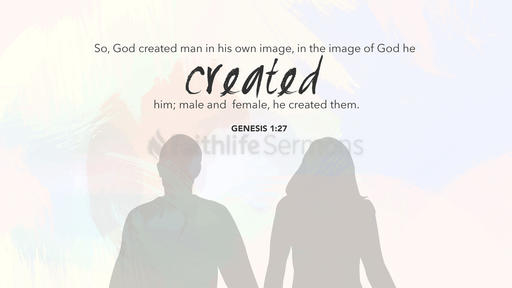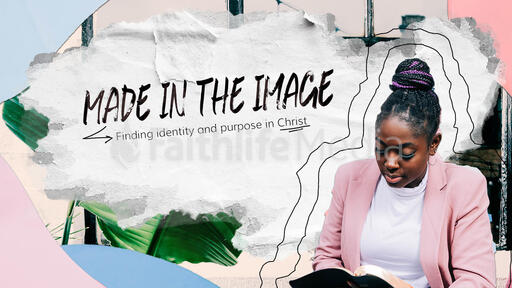In His Image
0 ratings
· 7 viewsNotes
Transcript
Sermon Tone Analysis
A
D
F
J
S
Emotion
A
C
T
Language
O
C
E
A
E
Social
Introduction
Introduction
A couple of months ago, God laid upon my heart the idea for this weekend. I wanted to keep the weekend simple because. let’s face it, men are always being told what to do. We go to work and are told what to do. We go home and are told what to do. I am a realist, and understand that a weekend at camp must have a little structure, so I am sure that we will be told what to do at times. But I really wanted this to be low programmed.
When I was thinking about the weekend, God laid upon my heart this idea of “Being Man”, and all that it entails. Tonight, we are going to look at how we are created in His image and what that means. Tomorrow night, Major Tom is going to share with us about the fall and restoration. Then on Sunday morning, we will wrap the weekend up looking at our commission to responsible ministry.
I don’t know about you, but I love college sports. I love everything about them, I really do! At the apex of college sports, at least in my world, college football reigns supreme.
If you are like me, then you will be well aware of the NIL debate and the fact that the NCAA approved policy this past year to allow student athletes to be compensated for the use of their Name, Image and Likeness.
Some people believe that it will ruin college athletics while others think that it will make them better. I think it will, and already is, changing the landscape of college athletics but am not ready to throw an opinion in of how it will do so just yet. I will simply say that where the love of money lurks, the devil isn’t far behind! We learn that from scripture, but I have a habit of going down rabbit trails and I don’t want to lose focus on this NIL thing because even though its associated topic has been heavily linked to college sports, its origins rest with God and man in scripture. Check this out...
Scripture
Scripture
Genesis 1:26-28 “Then God said, “Let us make human beings in our image; in our likeness. They will reign over the fish in the sea, the birds in the sky, the livestock, all the wild animals on the earth, and the small animals that scurry along the ground.” So God created human beings in his own image. In the image of God he created them; male and female he created them. Then God blessed them and said, “Be fruitful and multiply. Fill the earth and govern it. Reign over the fish in the sea, the birds in the sky, and all the animals that scurry along the ground.””
Historical Context
Historical Context
I always like to offer some historical context of a scripture before launching into a sermon, but it doesn’t get much more historical than this, does it!. This is at the conception of the human race. God has just established space and time as well as having made all of the elements to support life. He has created his garden along with its animal inhabitants, and is now finishing up with His crown jewel, mankind!
His Image
His Image
Ands we really are the crown jewel. One of the early church fathers said it like this, “Men go forth to wonder at the heights of mountains, the huge waves of the sea, the broad flow of the rivers, the extent of the ocean, and the courses of the stars, yet omit to wonder at themselves.”
St. Augustine believes that we are something to be marveled at, and you should too! But it’s not in and of ourselves that we are special. No! What makes us special is the fact that we are created in His image; His likeness! We can have a positive view of mankind because a high and reverent view of God leads to a noble and dignified view of man! If we revere The Lord, then it is natural to regard those whom He has created in His image.
So what exactly does it mean to be created in God’s image? There are a few thoughts about this. Some consider our physical attributes, but I don’t think that’s accurate because John 4:24 reminds us that God is spirit. It is difficult for us to wrap our minds around this concept. After all, the bible makes multiple anatomical reference of God. 2 Chronicles 16:9 references God’s eyes, and Matthew 4:4 His mouth. But biblical writers have used this helpful tool called anthropomorphism as a way of helping us to comprehend the incomprehensible through association. It is a valuable and necessary conveyance, but certainly not intended to help define image and likeness, not in physical terms at least.
Another view of being created in the image of God is derived through considering His personality, for instance, His intellect and will. It’s indisputable to question that we have likeness to God in these areas, though extremely deminished when considering His infinence against our limitations. I think that is something that we should further consider, so let’s park that for a moment and come back to it.
A deeper dive into the word “image” used in this evening’s Genesis 1:27 scripture brings us to the orginal hebrew word used “Tselem” which most closely translates to a “representation or statue”. As I am studying this, I was reminded that some kings, in very ancient times, would place statues of themselves in faraway parts of their kingdoms. These statues were meant to remind the inhabitants that they were part of an empire.
Having served in the military overseas, I can understand this because although I was stationed in foreign countries, each designated area had a US flag flying, a symbol that constantly reminded me that though separated from the whole, I belonged to something; I was committed to something. Even of greater importance, I represented something.
So, I think that this idea of image as representation warrants some consideration. I think that we were created in His image to stand as a constant reminder that the earth and its inhabitants belong to God, that this place is part of His kingdom. But it feels like stopping there would leave it incomplete, so let’s go a little further this evening before stopping.
Perhaps the next place we should jump to is Genesis 2:7 which says that “The Lord God formed man from the dust of the ground and breathed into his nostrils the breath of life, and the man became a living being”.
The imagery that this verse creates is so powerful. Consider The Lord bending down and with His own breath, breathing life into Adam.
He gives of Himself here, doesn’t He! Just as as we were dead in sin and He gave of His own Son that we might have life, we see in this verse a precursor of that very moment. He imparted His own life giving breath. So our representation goes further than a statuesque image, doesn’t it!?!? If He imparted something of Himself within, then it is the image within that we need to most greatly review.
Perhaps we should consider the teachings of a much revered patriarch in the Wesleyan tradition. John Wesley, himself, taught that the Image of God could be defined by 3 primary aspects: natural, political, and moral.
The Natural Image
The Natural Image
By the natural image, Wesley was speaking of the human power of understanding, our will, and the freedom to exercise that will by choosing. Perhaps there is no greater scripture that points to the free will of humanity than Revelation 3:20 where Jesus says “Here I am! I stand at the door and knock. If anyone hears my voice and opens the door, I will come in and eat with that person, and they with me”.
Even though God highly desires a relationship with us, He doesn’t kick the door in, does He?!?. He merely knocks and awaits us to welcome Him and invitate Him in. So we are able to understand, and through that understanding, we are able to make a choice, one that God will honor. That’s the first part of the Imago Dei for Wesley.
The Political Aspect
The Political Aspect
The second is the Political aspect. This would be the ability and responsibility of exercising protective control over the created ecological system.
The second doctrine of The Salvation Army affirms that God is “the Creator, Preservor, and Governor of all things”. He cares for His entire created order. Jesus confirms this doctrine in Matthew 5 where in verse 45 He says that God “causes the sun to rise on the evil and the good, and sends rain for the righteous and the unrighteous”.
Just as God exercises characteristics akin to political responsibility, we are created for a similar purpose. Human responsibility to care for the created order is peperred throughout the whole of scripture. Genesis 1 says that we are given dominion over other living things, Genesis 2:15 has Adam working and caring for the garden. Even Matthew 5 which we just referenced calls for us as God’s sons to care for the same things that He does. So, that is the second part of Wesley’s Imago Dei.
Moral Aspect
Moral Aspect
Last of Wesley’s Imago Dei, but certainly not least, is the Moral aspect. People often think that morality is something new, something that was introduced with acceptance of Jesus and the indwelling of the Holy Spirit. But it isn’t new to mankind, it is only reintroduced through those relationships made necessary by the fall of man. Ecclesiastes 7:29 says that “God made mankind upright”. We were created with this moral aspect of the Imago Dei.
Communion
Communion
So, there we have it! Man is a representation of God through the ability to exercise free will, through a responsibility to care for the created ecosystem, and through a life of righteousness. But I think something that is often overlooked when we consider being created in God’s image is the necessity of constant communion with Him. It was Adam walking with God in communion that was special. It is being joined with Christ, the indwelling of the Holy Spirit. Apart from communion with God, the Imago Dei is completely lost. So as we go throughout this weekend talking about “Being Man”, continue to think about our likeness with God, and its dependence for ongoing communion.
I think that is probably a good place to stop this evening. Let’s Pray!
ADVERTISEMENT
Related Media
See moreRelated Sermons
See more

SD Test Account • 29 views


Moses min • 2 views


